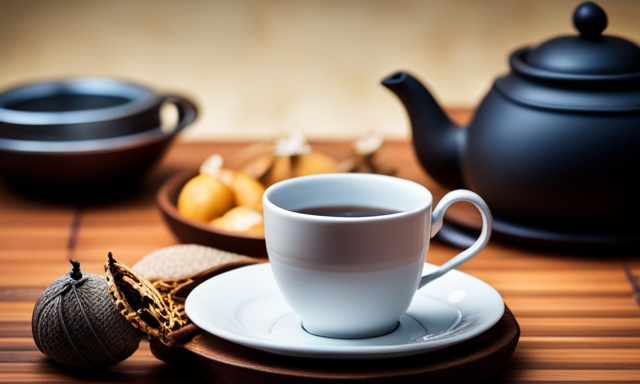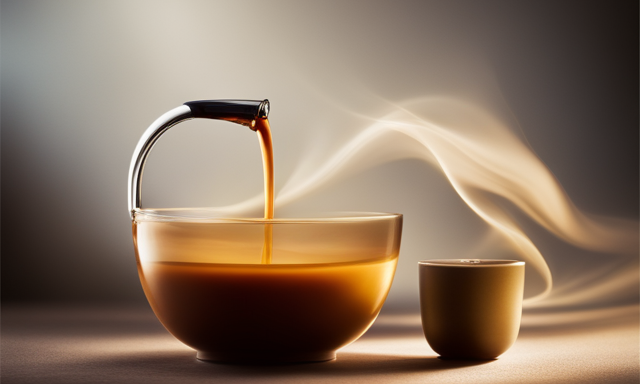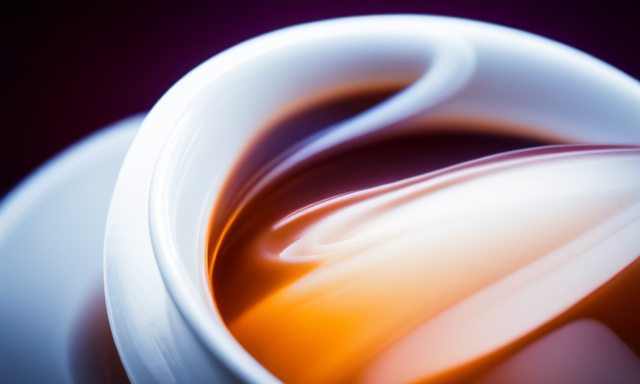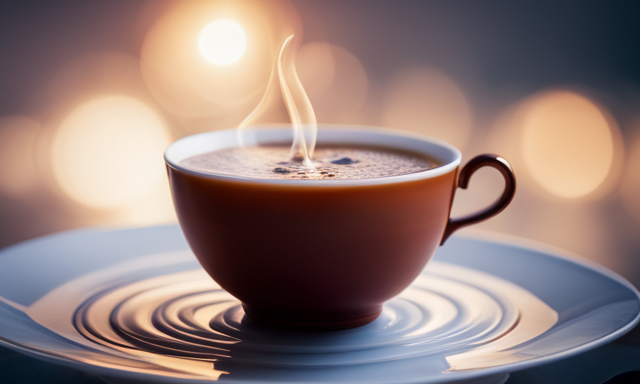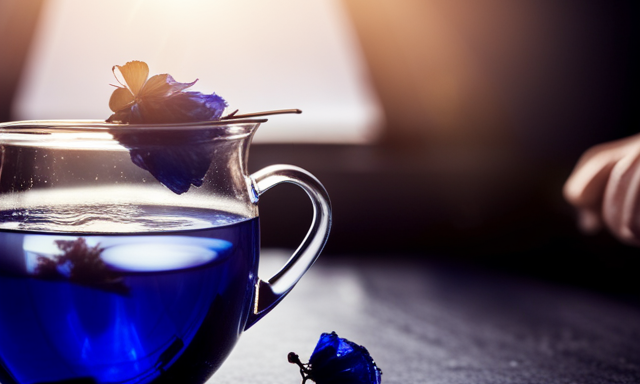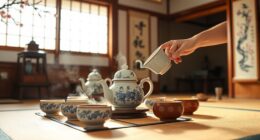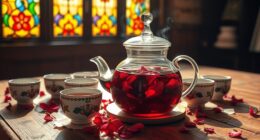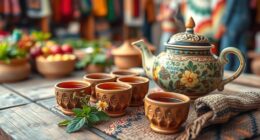Did you know that oolong tea and green tea have distinct differences in flavor, caffeine content, and health benefits?
It’s fascinating to explore the unique characteristics of these two popular teas. In this article, I will delve into the origins of oolong tea and green tea, compare their flavor profiles, analyze their caffeine content, and highlight the various health benefits associated with each.
Additionally, I will provide brewing methods for both types of tea and discuss their culinary applications. By the end, you will have a comprehensive understanding of how oolong tea differs from green tea and be equipped to make an informed choice when deciding which one to enjoy.
So let’s embark on this tea-tasting journey together and discover the wonders of oolong tea and green tea.
Key Takeaways
- Oolong tea offers a wide range of flavors, while green tea has a more delicate and grassy taste.
- Proper brewing techniques and temperature are important for both types of tea.
- Oolong tea is suitable for savory dishes, while green tea is suitable for light and refreshing dishes.
- Both teas have health benefits due to their high antioxidant content.
The Origins of Oolong Tea and Green Tea
Let’s dive into the fascinating origins of both oolong tea and green tea! The origins of oolong tea can be traced back to the Fujian province in China. It is believed that oolong tea was first produced during the Ming Dynasty. The unique processing method of oolong tea involves withering the leaves under the sun, then shaking them to bruise the edges, and finally oxidizing them to a desired level.
On the other hand, green tea has its origins in China and Japan. It’s believed that green tea was first brewed in China during the Tang Dynasty. The processing of green tea involves pan-frying or steaming the leaves to prevent oxidation.
Now that we’ve explored the origins of these teas, let’s move on to the flavor profiles of oolong tea and green tea.
Flavor Profiles of Oolong Tea and Green Tea
Oolong tea is known for its distinct aroma and taste, which sets it apart from other types of tea. Its aroma can range from floral and fruity to toasty and nutty, while its taste can be smooth and sweet with a hint of honey or have a more robust and earthy flavor.
On the other hand, green tea is characterized by its fresh and vegetal notes. It has a grassy and slightly bitter taste, often described as refreshing and invigorating.
Understanding the flavor profiles of oolong tea and green tea can help tea enthusiasts appreciate the unique qualities of each type of tea.
Oolong Tea’s Distinct Aroma and Taste
Experience the unique aroma and taste of oolong tea, which sets it apart from green tea, and discover a whole new world of sensory delight. Oolong tea undergoes a partially oxidized process, giving it a distinct flavor profile. The brewing techniques for oolong tea are crucial in extracting its full potential. Delicately steeping the leaves at the right temperature and time allows the tea to unfold its complex flavors, ranging from floral and fruity to nutty and toasty.
When it comes to oolong tea, the oxidation process plays a significant role in shaping its taste. By allowing the tea leaves to undergo partial oxidation, the result is a rich and layered flavor profile that lies between the lightness of green tea and the robustness of black tea. This unique characteristic makes oolong tea a delightful choice for those seeking a balance between the two extremes.
Now, let’s explore the fresh and vegetal notes that green tea has to offer.
Green Tea’s Fresh and Vegetal Notes
Green tea offers a delightful blend of fresh and vegetal flavors that are both invigorating and soothing to the senses. Its unique taste comes from the way it’s processed, which helps retain its natural green color and distinct flavor profile.
The fresh notes in green tea come from the minimal oxidation process it undergoes, preserving its vibrant taste. Additionally, green tea is known for its high antioxidant properties, which help protect the body against free radicals and promote overall health.
While oolong tea is often praised for its weight loss benefits, green tea also has its own advantages when it comes to maintaining a healthy weight.
Transitioning into the next section, it’s important to note that green tea and oolong tea also differ in terms of their caffeine content.
Caffeine Content Comparison
When it comes to caffeine content, oolong tea falls in the middle ground with moderate levels. It offers a pleasant energy boost without the jittery side effects that can come with higher caffeine drinks.
On the other hand, green tea has lower caffeine content compared to oolong tea, making it a great choice for those who are more sensitive to caffeine or prefer a milder stimulant.
Overall, understanding the caffeine levels in these teas can help individuals make informed decisions about their beverage choices based on their energy needs and preferences.
Oolong Tea’s Moderate Caffeine Levels
To truly appreciate oolong tea, imagine sipping a cup that energizes you like a gentle breeze on a warm summer’s day. Oolong tea contains moderate levels of caffeine, which makes it a perfect choice for those who want a balanced boost without the jitters. Unlike green tea, oolong tea’s caffeine metabolism is slower due to its partial oxidation during processing. This slow release of caffeine provides a sustained energy lift, preventing the sudden crash that can occur with other caffeinated beverages. Additionally, oolong tea has been found to have a positive impact on sleep quality. Its moderate caffeine content allows for a restful night’s sleep, unlike high-caffeine drinks that can disrupt sleep patterns. Transitioning to the subsequent section, let’s explore how green tea’s lower caffeine content offers a different experience.
Green Tea’s Lower Caffeine Content
Moving on to the current subtopic, it’s important to highlight that green tea generally contains lower levels of caffeine compared to oolong tea. This difference in caffeine content is significant as it directly affects the impact of each tea on our bodies. Green tea’s lower caffeine content makes it a great option for those who are sensitive to caffeine or prefer a milder stimulant effect.
Additionally, green tea has been found to have a positive impact on metabolism, which can aid in weight management. On the other hand, oolong tea’s moderate caffeine levels, combined with its unique blend of antioxidants, have shown potential weight loss effects. This makes oolong tea an intriguing option for individuals looking to support their weight loss goals.
Transitioning into the subsequent section about the health benefits of oolong tea, it’s important to explore its numerous advantages.
Health Benefits of Oolong Tea
Try incorporating phrases like ‘Discover’ or ‘You’ll be amazed to learn’ to engage the audience.
Did you know that drinking oolong tea can provide you with a wide range of health benefits?
Oolong tea is known for its impact on weight loss. It contains polyphenols that increase metabolism and fat oxidation, helping you shed those extra pounds.
Additionally, oolong tea has been found to regulate blood sugar levels. It helps to lower blood sugar levels by improving insulin sensitivity and reducing insulin resistance. This can be particularly beneficial for individuals with diabetes or those at risk of developing it.
These health benefits of oolong tea are just the beginning. As we explore the health benefits of green tea, you’ll be amazed to learn how it can further enhance your well-being.
Health Benefits of Green Tea
You’ll be amazed to discover the myriad of health benefits that come from incorporating this herbal elixir into your daily routine. Green tea offers a wide range of advantages, including aiding in weight loss and cancer prevention. Studies have shown that the catechins present in green tea can help increase metabolism and promote fat oxidation, making it an excellent addition to a weight loss regimen. Additionally, the high levels of antioxidants in green tea have been linked to reducing the risk of various types of cancer, such as breast, prostate, and colorectal cancer.
To better understand the health benefits of green tea, refer to the following table:
| Health Benefits of Green Tea |
|---|
| Aid in weight loss |
| Help prevent cancer |
| Rich in antioxidants |
| Boost metabolism |
| Improve brain function |
Now, let’s move on to the next section and explore the brewing methods for oolong tea.
Brewing Methods for Oolong Tea
To fully appreciate the exquisite flavors and aromas of oolong, one must master the art of brewing this delicate beverage. Oolong tea offers a wide range of flavor profiles, from floral and fruity to woody and roasted. Each variety of oolong has its own unique characteristics, which can be brought out through proper brewing techniques.
One important factor in brewing oolong tea is water temperature. Generally, oolong tea is best brewed with water that’s around 185-205°F (85-96°C). Steeping times can range from 1-5 minutes, depending on the desired strength.
Additionally, the use of a gaiwan or a clay teapot can enhance the brewing process by allowing the flavors to fully develop. Understanding these brewing techniques will ensure a perfect cup of oolong tea every time.
Now, let’s delve into the brewing methods for green tea.
Brewing Methods for Green Tea
Once you step into the serene world of green tea brewing, you’ll find yourself floating on a cloud of delicate flavors and fragrances. Green tea, like oolong tea, offers a wide variety of brewing methods that can enhance its unique characteristics. Different types of green tea, such as sencha, matcha, and dragonwell, require specific brewing techniques to bring out their distinct flavors. Brewing green tea with loose leaves allows for a more nuanced and flavorful cup, as the leaves have more room to unfurl and release their essence. Loose leaf green tea also contains higher levels of antioxidants, providing numerous health benefits. To fully appreciate the nuances of green tea, it is essential to experiment with different brewing methods and explore the diverse range of flavors it has to offer. Transitioning into the subsequent section about ‘oolong tea and green tea in culinary applications’, the versatility of both these teas lends them well to various culinary delights.
Oolong Tea and Green Tea in Culinary Applications
Get ready to explore the exciting world of culinary applications for these versatile teas! Oolong tea and green tea can both be used in various culinary dishes to add unique flavors and health benefits.
Oolong tea is often used in cooking to infuse its distinct floral and fruity notes into desserts, marinades, and even cocktails. Its rich and complex flavor profile makes it a popular choice for pairing with seafood and poultry dishes.
On the other hand, green tea is commonly used in baking, ice creams, and smoothies to provide a refreshing and earthy taste. Additionally, the health benefits of green tea, such as its high antioxidant content and potential weight loss properties, make it a popular choice for incorporating into culinary applications.
Now let’s explore how to choose between oolong tea and green tea for your next cooking adventure.
Choosing Between Oolong Tea and Green Tea
When deciding which type of tea to use in your culinary creations, you’ll be faced with the choice between the versatile flavors and health benefits of oolong and green tea.
Both oolong tea and green tea have distinct characteristics that make them suitable for different culinary applications. One key factor to consider is the brewing temperature. Oolong tea is typically brewed at a higher temperature compared to green tea. This results in oolong tea having a stronger and more robust flavor that can withstand being used in savory dishes or as a base for marinades.
On the other hand, green tea is known for its delicate and grassy flavor, making it a great choice for light and refreshing dishes like salads or desserts.
Additionally, when it comes to antioxidant content, both oolong and green tea are rich sources. However, green tea is often considered to have a higher concentration of antioxidants, which can provide numerous health benefits.
Frequently Asked Questions
What are the different types of oolong tea and green tea available?
Oolong tea has a wide variety of types, including Tie Guan Yin and Da Hong Pao, while green tea has variations like Sencha and Matcha. Both teas offer weight loss benefits due to their metabolism-boosting properties.
How long does it take to brew oolong tea and green tea?
To brew oolong tea, the steeping process takes about 3-5 minutes using water at 190-200°F. Green tea, on the other hand, requires a shorter brewing time of 1-3 minutes with water at 160-180°F.
Can oolong tea and green tea be used as ingredients in baking?
Yes, both oolong tea and green tea can be used as ingredients in baking. They add unique flavors and health benefits. Oolong tea aids digestion and metabolism, while green tea is rich in antioxidants and can boost brain function.
Are there any specific health conditions for which oolong tea or green tea is recommended?
Oolong tea and green tea have specific health benefits. They both contain antioxidants that can help reduce the risk of chronic diseases. Compared to other types of tea, oolong tea is known for its metabolism-boosting properties, while green tea is known for its weight loss benefits.
What are the environmental impacts of oolong tea and green tea production?
When it comes to the environmental impacts of oolong tea and green tea production, it’s like comparing a drop of water to a rainstorm. Oolong tea has a lower carbon footprint and is more environmentally sustainable than green tea.
Conclusion
In conclusion, after carefully examining the origins, flavor profiles, caffeine content, health benefits, brewing methods, and culinary applications of both oolong tea and green tea, it’s clear that these two teas have their unique characteristics.
While oolong tea is known for its rich and complex flavors, green tea offers a light and refreshing taste.
Both teas have their own set of health benefits, making them a great addition to any diet.
So, whether you prefer the depth of oolong or the simplicity of green, the choice ultimately comes down to personal preference. As the saying goes, "Different strokes for different folks."


